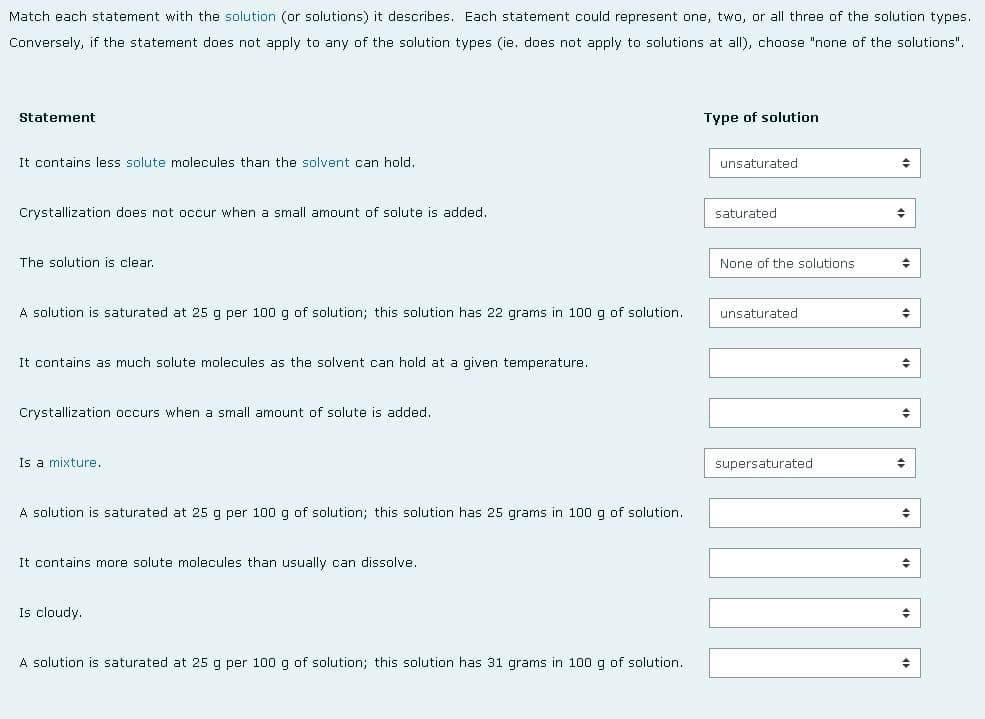Match each statement with the solution (or solutions) it describes. Each statement could represent or Conversely, if the statement does not apply to any of the solution types (ie. does not apply to solution Statement It contains less solute molecules than the solvent can hold. Crystallization does not occur when a small amount of solute is added. The solution is clear.
Match each statement with the solution (or solutions) it describes. Each statement could represent or Conversely, if the statement does not apply to any of the solution types (ie. does not apply to solution Statement It contains less solute molecules than the solvent can hold. Crystallization does not occur when a small amount of solute is added. The solution is clear.
Chemistry for Today: General, Organic, and Biochemistry
9th Edition
ISBN:9781305960060
Author:Spencer L. Seager, Michael R. Slabaugh, Maren S. Hansen
Publisher:Spencer L. Seager, Michael R. Slabaugh, Maren S. Hansen
Chapter7: Sollutions And Colloids
Section: Chapter Questions
Problem 7.2E
Related questions
Question
Can you tell me what each question is from the beginning, please?
Also can you give me some reasoning on why it is that?

Transcribed Image Text:Match each statement with the solution (or solutions) it describes. Each statement could represent one, two, or all three of the solution types.
Conversely, if the statement does not apply to any of the solution types (ie. does not apply to solutions at all), choose "none of the solutions".
Statement
Type of solution
It contains less solute molecules than the solvent can hold.
unsaturated
Crystallization does not occur when a small amount of solute is added.
saturated
The solution is clear.
None of the solutions
A solution is saturated at 25 g per 100 g of solution; this solution has 22 grams in 100 g of solution.
unsaturated
It contains as much solute molecules as the solvent can hold at a given temperature.
Crystallization occurs when a small amount of solute is added.
Is a mixture.
supersaturated
A solution is saturated at 25 g per 100 g of solution; this solution has 25 grams in 100 g of solution.
It contains more solute molecules than usually can dissolve.
Is cloudy.
A solution is saturated at 25 g per 100 g of solution; this solution has 31 grams in 100 g of solution.
Expert Solution
This question has been solved!
Explore an expertly crafted, step-by-step solution for a thorough understanding of key concepts.
Step by step
Solved in 2 steps

Knowledge Booster
Learn more about
Need a deep-dive on the concept behind this application? Look no further. Learn more about this topic, chemistry and related others by exploring similar questions and additional content below.Recommended textbooks for you

Chemistry for Today: General, Organic, and Bioche…
Chemistry
ISBN:
9781305960060
Author:
Spencer L. Seager, Michael R. Slabaugh, Maren S. Hansen
Publisher:
Cengage Learning


World of Chemistry, 3rd edition
Chemistry
ISBN:
9781133109655
Author:
Steven S. Zumdahl, Susan L. Zumdahl, Donald J. DeCoste
Publisher:
Brooks / Cole / Cengage Learning

Chemistry for Today: General, Organic, and Bioche…
Chemistry
ISBN:
9781305960060
Author:
Spencer L. Seager, Michael R. Slabaugh, Maren S. Hansen
Publisher:
Cengage Learning


World of Chemistry, 3rd edition
Chemistry
ISBN:
9781133109655
Author:
Steven S. Zumdahl, Susan L. Zumdahl, Donald J. DeCoste
Publisher:
Brooks / Cole / Cengage Learning

General, Organic, and Biological Chemistry
Chemistry
ISBN:
9781285853918
Author:
H. Stephen Stoker
Publisher:
Cengage Learning

Living By Chemistry: First Edition Textbook
Chemistry
ISBN:
9781559539418
Author:
Angelica Stacy
Publisher:
MAC HIGHER

Chemistry: Matter and Change
Chemistry
ISBN:
9780078746376
Author:
Dinah Zike, Laurel Dingrando, Nicholas Hainen, Cheryl Wistrom
Publisher:
Glencoe/McGraw-Hill School Pub Co